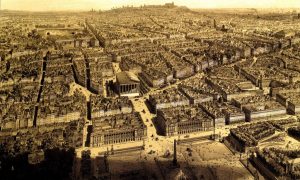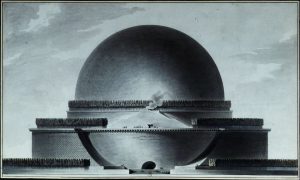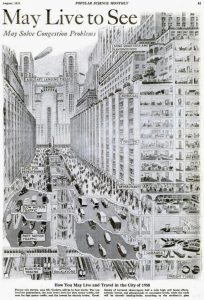Visionary City-making: A History of the Future
By Garrett Newman
Date
December 9, 2016‘Defining the Cities of Tomorrow’ is a bold, grand and celebratory statement that is set within the context of a bright and positive future for cities. Yet, it is also a statement that harkens back to the age-old tradition of city visioning.
Such a tradition can be sourced to the days of Mesopotamia, when cities began to take on a denser and more complex form that we recognize in cities today. It would be more than a millennium before the basis for modern city visioning would emerge. The roots of modern city visioning can be drawn to the late medieval and early renaissance period when city visions were drastically transformed and based on a new world society that revolved around logic, science, rationale principles, and human achievement. It was during this period that revolutionary city visions were created, including Da Vinci’s 1488 drawing of a multi-leveled town, More’s 1516 The Island of Utopia, and Bruegel’s 1563 The Building of the Tower of Babel. Since then, an array of city visions have been created that, when looked as a collective whole, have significantly influenced the evolution of cities. This evolution is impeccably documented in Donna Goodman’s 2008 book A History of the Future.

Baron von Haussmann’s Paris Image via Wikimedia Commons
In A History of the Future, Goodman clearly outlines the evolution of modern city visioning from its infancy through to current day, covering each unique vision and discussing the planner, architect, engineer and/or artist responsible for creating it. The 286-page read is detailed and layered with well-structured information, showcasing the deep and rich history of city visioning throughout the centuries and the key individuals, groups and/or manifestos associated with each historical period. Ultimately, the key takeaway from Goodman’s book is the critical importance of vision in any city planning, design, development and engineering pursuit. Although Goodman does not state outright the importance of vision, it is clear near the conclusion of the book that Goodman’s purpose for chronicling the history of modern city visioning is to emphasize such importance.

Isaac Newton’s Cenotaph Image via World Digital Library
A number of important themes are raised through Goodman’s concluding emphasis on the importance of vision, the likes of which could be translated into the following statements:
- Without the city visions of the past, cities may not be what they are today (a statement that is clearly showcased on the cover of Goodman’s book through the comparison of Boullee’s Newton’s Cenotaph and Buckminster Fuller’s Montreal Biosphere);
- Without city vision, there is no city progression;
- Without vision, there is no achievement or accomplishment.
Acting in tandem with these themes are a number of questions regarding city vision:
- What city visions are being produced today that will influence the cities of tomorrow?
- What roles should the public and private sectors play in producing city visions?
- How important of a role does the necessity to solve environmental and social problems play in the creation of new city visions?
As 2016 comes to close, an ideal opportunity is presented to pause for a moment and apply critical thought to the themes and questions raised by A History of the Future. How are these questions and themes connected to our role in “Defining the Cities of Tomorrow”, and what does that truly mean? Ask yourself what the cities of tomorrow should look and function like. Ask yourself what issues and challenges the cities of tomorrow should help alleviate. Ask yourself what role you would like to play in defining the cities of tomorrow, and what role(s) you think city-makers like IBI Group should play. And finally, ask yourself how the city visions of today should be documented and distributed to governments and the industry at large.
‘Defining the Cities of Tomorrow’ is not a statement that should be taken lightly. It holds great importance and should be both discussed and acted upon whenever and wherever possible.

Harvey Wiley Corbett’s New York City of the Future Image via Popular Science Monthly. Click here for larger image.







